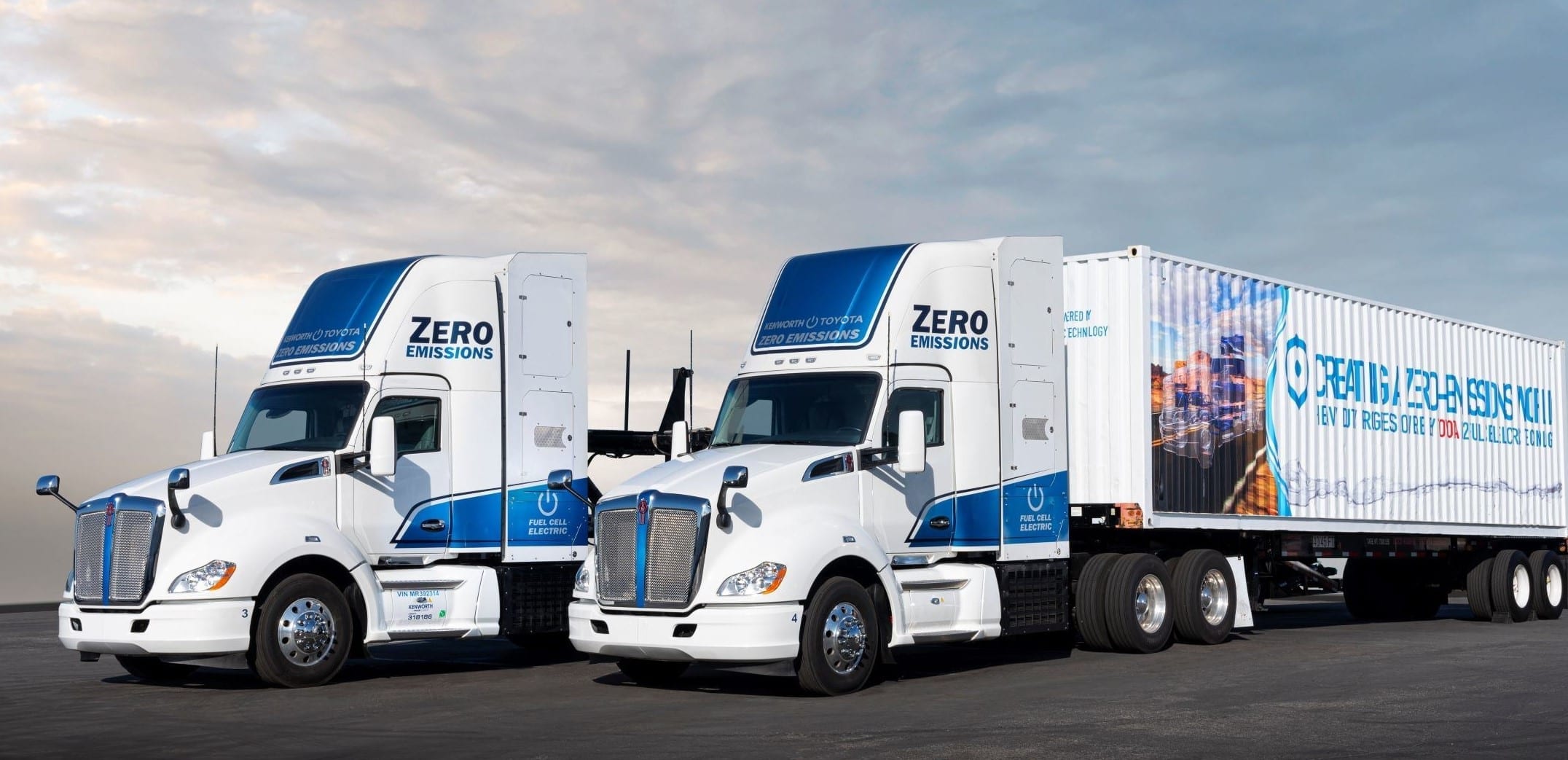While medium- and heavy-duty battery electric vehicles make headlines daily with new products and deployments, fuel cell electric vehicles (FCEV) are turning heads whenever news hits the wire. Recently, Toyota announced that a pair of Kenworth T680 Class 8 trucks powered by a Toyota fuel cell electric drivetrain will be making the rounds at the Ports of Los Angeles and Long Beach, an early Christmas present for some Southern California fleets.
As part of the Zero and Near Zero Emissions Freight Forwarding (ZANZEFF) project, a sub-program under the California Air Resources Board’s (CARB) Low Carbon Transportation Program, a total of 15 zero emission Class 8 trucks — which will soon include a total of 10 fuel-cell-powered Kenworth trucks — are making their way around the state.
“This is a viable, sustainable, and hopefully, cost effective alternative to fossil fuels,” said Gordon Reimer, president, Southern Counties Express, one of the two drayage fleets to receive the fuel cell truck. “The benefits will play out as more are deployed into service.”
As part of ZANZEFF a total of 15 zero emission Class 8 trucks are making their way around the state.
Fuel Cell Trucks Developed as Part of ZANZEFF
The Kenworth T680 FCEV, which was developed as part of the $41 million ZANZEFF grant, was first unveiled on Earth Day 2019 — created through a partnership with Toyota and an expansion on the capabilities of the automaker’s first Project Portal Proof of Concept truck. This 80,000-pound truck was powered by two Toyota Mirai fuel cell stacks and had a range of 200 miles, which, in the FCEV’s current model, now includes a scaled-up version of the 2021 Toyota Mirai’s fuel cell stack with a range of up to 300 miles.
“The ZANZEFF pilot program is an important step toward proving the capabilities of fuel cell electric trucks in daily drayage operations,” said Ed Hellwig, safety and quality communications manager at Toyota North America. “Fleet operators want to know that a new technology is reliable before investing, and this program will go a long way toward instilling that confidence.”
The FCEV truck’s extended range over battery-electric trucks might be the key to opening up a greater acceptance of this technology. However, its need for infrastructure might be the lock that forces it in the opposite direction, but Reimer is confident in the future.
“The infrastructure behind the technology is what is needed, and we see that being developed at the same pace as the trucks themselves, so we are optimistic that this will be the technology choice for the future,” he said.
The FCEV truck’s extended range over battery-electric trucks might open up a greater acceptance of this technology.
Port of Long Beach has the State’s Only Heavy-Duty Hydrogen Fueling Station
And in terms of upcoming infrastructure, California is taking the bull by the horns according to the California Hydrogen Business Council (CHBC), which pointed out that the state recently approved 130 new stations for commercially available light-duty vehicles, bringing the total closer to 200 stations. The Port of Long Beach also has the state’s only heavy-duty station to help support the ZANZEFF project.
“We expect the success of this project will initiate the deployment of many heavy-duty stations across the western U.S.,” said CHBC Executive Director Bill Zobel. “The good news is fuel providers are investing with more certainty, creating a sustainable long-term market for hydrogen as a transportation fuel.”
California’s ACT Regulation Pushes Zero Emission Trucks
These drayage pilot programs could also help steer the way for a zero emission fuel cell future that is commercially viable. With California’s Advanced Clean Trucks (ACT) Regulation 2035 deadline coming sooner than most fleets are ready for, this could be the technology to help pave the way to meet the federal air quality standards that pushed the state to adopt this regulation. According to the ACT regulation, truck manufacturers will be required to sell a specific number of zero emission trucks beginning in 2024. By 2035, they must account for 40% of Class 7-8 tractors.
These drayage pilot programs could help steer the way for a zero emission fuel cell future that is commercially viable.
“The industry is looking for real, substantiated evidence that this technology is for real and that it works in real world applications,” said Reimer, who sees this pilot as the ability to provide an honest assessment of this technology to his industry peers. “If the true cost of ownership is less than fossil fuel trucks, and the reliability is comparable or better, it will be an easier sell to the industry.”
With this project comes a unique opportunity for fleet operators, according to CHBC’s Zobel, giving the commercial truck sector the ability to test this technology under real world load conditions. This first step in the commercialization process for hydrogen technology in the commercial truck industry will also help support future deployments.
“These will be followed by commercial products that incorporate the learnings that come from these trials,” added Zobel. “The transit market is a good example and has already broken the barrier in the heavy-duty FCEV market with several FCEV buses deployed and more on the way. We see a bright future for FCEV trucks in the years ahead.”



